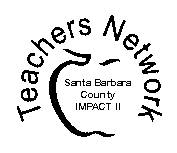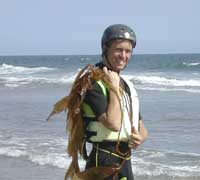The TeachNet Project sponsored with major funding by the AT&T Learning Network,
seeks to improve student achievement by providing training, grants, networking and resource sharing to teachers at four of the Teachers Network affiliates nationwide.


www.qad.com
FORESTS UNDER THE SEA
How
it works:
"Forests
Under the Sea" is an interdisciplinary, technology-based unit
designed to introduce middle to high school students to the
hidden world of giant kelp forests. "Forests Under the Sea"
encourages students to understand the biology of these
underwater forest ecosystems through reading, drawing,
observing, constructing models, and the use of technology. The
unit builds knowledge and understanding of kelp ecosystems from
the biology of a single plant, to the ecology of a kelp forest,
including a comparison of that forest with the more familiar
tropical rain forests of the world. By the end of the unit,
students will have built a "kelp forest" in their classroom
based on the knowledge they have gained. The entire unit should
take 15-30 class periods, depending on age and ability, as well
as the teacher's selection of activities and the depth of their
instructional. The unit makes use of ideas and information
found in the Jason XIV curriculum entitled, "From Shore to
Sea". If interested, see www.jason.org and register for the
"Jason XIV Plus" curriculum for additional activities).
Assessment:
The unit uses a variety of learning modalities for students to
express their knowledge and understanding. Teachers thus have
the opportunity to assess student work incrementally as the unit
progresses. They may collect each assignment and provide
written feedback as well as monitor individual and group work
and give verbal feedback. Lastly, the final lesson encourages
students to synthesize their knowledge and provides the teacher
a final assessment of student concept comprehension. In all
cases, students are encouraged to assess their own and their
peers' work both formally and informally.
Standards:
California Content Standards Met
6th grade Ecology (Life Science)
5. Organisms in ecosystems exchange energy and nutrients among themselves and with the environment. As a basis for understanding this concept:
a. Students know energy entering ecosystems as sunlight is transferred by producers into chemical energy through photosynthesis and then from organism to organism through food webs.
c. Students know populations of organisms can be categorized by the functions they serve in an ecosystem.
d. Students know different kinds of organisms may play similar ecological roles in similar biomes.
7th grade Life Science
1. All living organisms are composed of cells, from just one to many trillions, whose details usually are visible only through a microscope. As a basis for understanding this concept:
f. Students know that as multicellular organisms develop, their cells differentiate.
2. A typical cell of any organism contains genetic instructions that specify its traits. Those traits may be modified by environmental influences. As a basis for understanding this concept:
a. Students know the differences between the life cycles and reproduction methods of sexual and asexual organisms.
6. The anatomy and physiology of plants and animals illustrate the complementary nature of structure and function. As a basis for understanding this concept:
a. Student know plants and animals have levels of organization for structure and function, including cells, tissues, organs, organ systems, and the whole organism.
b. Students know organ systems function because of the contributions of individual organs, tissues, and cells. The failure of any part can affect the entire system.
7. Students will:
b. Use a variety of print and electronic resources (including the World Wide Web) to collect information and evidence as part of a research project.
d. Construct scale models, maps, and appropriately labeled diagrams to communicate scientific knowledge.
e. Communicate the steps and results from an investigation in written reports and oral presentations.
9th-12th grade Biology
6. (Ecology) Stability in an ecosystem is a balance between competing effects. As a basis for understanding this concept:
a. Students know biodiversity is the sum total of different kinds of organisms and is affected by alterations of habitats.
e. Students know a vital part of an ecosystem is the stability of its producers and decomposers.
Estimated Number of Class Periods for Students To Complete Unit:
15-30 depending on students group size, instructor choice of activities, and depth of instruction.
What
you need:
Software or Materials Used:
In the best of situations, all students should have individual access to computers, speedy internet connections, and Microsoft PowerPoint software to complete the activities of the unit. In the absence of this, the creative teacher can piece together appropriate portions of the unit by printing out handouts. Many of the website resources could be shared with the class as a whole with the use of a classroom LCD projector and the teacher's computer. PowerPoint presentations also require the use of a classroom LCD projector. Of course, library resources and traditional research can be conducted and similar projects constructed in the absence of electronic technology. Lastly, basic classroom materials such as construction paper, scissors, glue, index cards, and magic colored markers/pencils should be available.
In order to access the worksheets and answer keys included in this site, you will need to have Acrobat Reader installed on your computer. It may be downloaded for free from the Adobe Acrobat website using the link below. (hyperlink)
In order to access Internet movies recommended by this site you will need to have RealOne Player installed on your computer. It may be downloaded for free from the RealOne Player website using the link below. (hyperlink)
Keywords:
kelp forests, kelp lessons, school PowerPoint projects, kelp and tropical forests, middle school life science lessons
The Students:
The unit has been taught in a middle school setting with classes between 15 and 30 students. The students have been of heterogeneous cultures, ethnicities, and socio-economic levels. Students have responded positively to the unit, especially the PowerPoint project. The author suspects that the unit would be equally successful at the high school level.
Overall Value:
This is an interdisciplinary, technology-based unit that exposes students to a world many have never heard of, less seen. It encourages students to express their knowledge and understanding through research and expository writing, drawing, acting, building models, and exploring the resources and capabilities for expression found in technology. Lastly, it requires students to express their subject matter competence across the range of Bloom's Taxonomy: knowledge, comprehension, application, analysis, synthesis, and evaluation
Details:
Subject Area:
Biology
Grade Levels:
7th through 12th
Tips for the Teacher:
"Forests Under the Sea" offers a range of activities to use in exploring the wondrous undersea worlds of the giant kelp forests. Many of the activities are not originally mine or unique. Do what I did: pick and choose, add to, and morph these activities into a unit that suits you and your students. Curriculum is most effective when it custom fits the needs of your students and community. This unit has ideas for you to take and dive with. Dive deeply!
Paul Sperry
Carpinteria Middle School
Email:
psperry@cusd.net
Paul Sperry has been a 7th and 8th grade
science teacher at Carpinteria Middle School for three years,
previously having taught 9th grade science at the
Zurich International School, Switzerland. He is a graduate of
Humboldt State University in Arcata, California with a B.S. in
Biology and received his M.Ed. and teaching credentials from the
University of California, Santa Barbara. An explorer at heart,
Paul's motivation for outdoor adventure and academic learning is
one and the same. His goal in the classroom is to spread this
passion in the context of understanding the beautiful complexity
that is our world.
